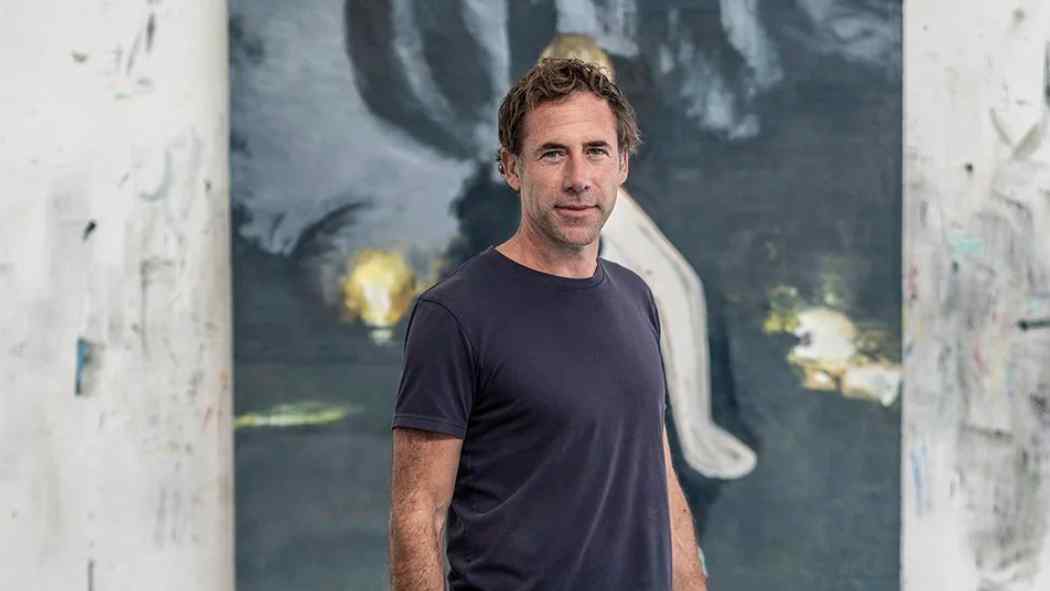Jonathan Wateridge: The Visionary Painter Redefining Contemporary Realism

Jonathan Wateridge is one of the most distinctive and thought-provoking painters in contemporary British art. His works, filled with cinematic precision and emotional subtlety, bridge the gap between reality and imagination. Born in Lusaka, Zambia in 1972 and now based in Norfolk, England, Wateridge has built a reputation for creating large-scale oil paintings that merge meticulous technique with deeply conceptual narratives. His approach to painting reimagines the traditional art form, breathing life into figuration at a time when abstraction and digital art dominate much of the modern scene.
Unlike artists who merely document what they see, Wateridge constructs worlds. He stages elaborate sets, hires models, and creates entire scenarios to photograph before translating them into paintings. Each canvas becomes a carefully orchestrated composition—part film set, part psychological study. His art challenges perceptions of authenticity, illusion, and identity, pushing viewers to question what is real and what is performed.
Early Life and Background
Jonathan Wateridge’s multicultural background profoundly influences his artistic sensibilities. Though born in Africa, he moved to the United Kingdom early in life, later studying at the Glasgow School of Art in the early 1990s. His education there coincided with a wave of experimentation in British contemporary painting, providing him with both classical discipline and the courage to explore unconventional narratives.
This early exposure to multiple cultures left Wateridge with a fascination for displacement, belonging, and constructed identity. These themes would later manifest vividly in his art, which often examines people caught between different realities or environments. His Zambian roots and British upbringing give him a unique duality—an outsider’s curiosity coupled with insider precision.
After completing his studies, Wateridge’s path to recognition was deliberate rather than instant. He took years to refine his craft, working privately before unveiling his monumental paintings to the public. When his work finally emerged in exhibitions, critics immediately noticed his unusual blend of technical mastery and conceptual ambition.
Artistic Philosophy and Approach
Wateridge’s process is as cinematic as it is painterly. He constructs full-scale sets in his studio, designs lighting conditions, and directs models as though filming a movie. The scenes are then photographed, and the resulting images serve as the foundation for his oil paintings. However, he never copies the photographs mechanically. Instead, he translates them into something far more textured, imbued with emotion, ambiguity, and painterly nuance.
He once said that the painting you begin is rarely the one you end up with—a statement that captures the transformative journey within his creative process. The paint itself becomes an active participant in shaping the final image, allowing for accidents, reinterpretations, and emotional re-imaginings.
Wateridge’s interest lies not in documenting reality but in exploring the layers of construction that shape it. Whether he paints suburban interiors, office scenes, or ambiguous outdoor spaces, his work reflects a fascination with how humans perform their identities within artificial frameworks.
Thematic Exploration
At the heart of Jonathan Wateridge’s art lies a preoccupation with illusion. His paintings operate at the intersection of fiction and truth. They depict recognisable figures—office workers, swimmers, architects, or anonymous faces—but always within an environment that feels subtly unreal. The lighting is too precise, the composition too arranged, and the expressions too calculated, giving viewers an uncanny sense of staged reality.
This deliberate artifice becomes a metaphor for modern life itself, where authenticity is constantly filtered through social roles, digital identities, and constructed appearances. Many of his works evoke the loneliness and ambiguity of the contemporary condition, capturing moments of stillness that feel both cinematic and deeply human.
In his more recent series, Wateridge has stripped away elaborate staging to focus on figures surrounded by minimal or abstract spaces. These ghost-like portraits and simplified compositions demonstrate his evolving interest in psychological interiority rather than surface realism. The result is an atmosphere of introspection and quiet tension, where the unspoken emotions of his subjects seem to fill the air.
Major Exhibitions and Recognition
Over the past two decades, Jonathan Wateridge has exhibited internationally in some of the most respected contemporary art venues. His representation by GRIMM Gallery in London and Amsterdam has solidified his global presence, and his solo exhibitions have drawn critical acclaim for their scale, precision, and emotional depth.
Among his notable solo shows are Enclave / Expatria and Uncertain Swimmer, each accompanied by meticulously produced monographs that explore his philosophy and process. These publications reveal the intellectual depth behind his art, showing him not just as a painter but as a thinker deeply engaged with questions of representation, identity, and belonging.
In 2025, his exhibition Vanishing Point at GRIMM Gallery in London marked another turning point. The show presented a series of works that explored the disappearance of human presence within modern spaces, symbolising the fragmentation of personal identity in an increasingly artificial world. Critics praised the exhibition for its atmospheric compositions and painterly bravery.
Wateridge’s art has also entered major private and public collections, including the Saatchi Collection in London, the Pinault Collection in Paris and Venice, the Aïshti Foundation in Beirut, and the AkzoNobel Art Foundation in the Netherlands. Such recognition places him among the most significant contemporary painters working today.
Artistic Style and Visual Language
Wateridge’s style merges classical oil technique with contemporary storytelling. His surfaces are rich in texture, light, and depth—often reminiscent of the old masters—yet his subjects are entirely modern. This combination gives his work an uncanny duality: timeless in craft, yet timely in theme.
His mastery of light deserves particular mention. He manipulates illumination as a narrative device, using it to reveal or conceal emotion. Shadows fall across faces like memories, while highlights isolate moments of vulnerability or introspection. The result is an atmosphere both theatrical and intimate, cinematic yet profoundly painterly.
Compositionally, Wateridge balances order and ambiguity. His paintings often feel like still frames from unseen stories. The viewer is left to imagine what came before or what might follow, an open-ended narrative that invites personal interpretation.
The Human Condition and Psychological Depth
One of the most compelling aspects of Jonathan Wateridge’s work is his ability to evoke psychological tension without overt drama. His figures rarely interact directly; instead, they exist in suspended moments, absorbed in private thoughts. This detachment captures the quiet isolation of modern existence—our simultaneous connection and disconnection within structured environments.
He often portrays people in ordinary or transitional states: waiting, swimming, walking, pausing. Yet these mundane actions become symbolic of something deeper. The viewer senses unspoken histories and emotional weight within these figures, as though each painting holds a hidden narrative.
This psychological layering aligns Wateridge with artists like Edward Hopper and Luc Tuymans, who use realism not to describe reality but to expose its emotional fractures. However, Wateridge’s method of constructing his subjects from staged photographs adds another layer of complexity—his realism is built upon deliberate artifice, mirroring the performative nature of identity itself.
Influence and Contribution to Contemporary Art
Jonathan Wateridge stands out for his commitment to painting at a time when digital media dominates the creative landscape. His works reaffirm the relevance of paint as a medium capable of expressing depth, ambiguity, and nuance in ways that photography or digital imagery cannot.
He challenges the assumption that painting is obsolete, instead using it as a tool to explore questions that feel distinctly modern. By merging cinematic composition with painterly gesture, he brings traditional craftsmanship into conversation with twenty-first-century ideas about perception, culture, and selfhood.
Many younger painters cite him as an influence, drawn to his rigorous process and intellectual clarity. His insistence on constructing images rather than simply capturing them has reinvigorated discussions around the relationship between painting, photography, and performance.
Market and Collectability
Wateridge’s works command significant attention in the art market. Collectors are drawn not only to the beauty of his paintings but also to their conceptual depth. Pieces such as Blue Swimmer and The Architects have achieved strong auction results, confirming his position among the leading figures in contemporary figurative art.
However, unlike many market-driven artists, Wateridge maintains a careful balance between production and integrity. Each series is methodically developed, often taking years of experimentation before reaching exhibition. This discipline ensures that his output remains both limited and deeply considered, enhancing its long-term value.
Critical Reception
Art critics frequently highlight Wateridge’s fusion of technical mastery and intellectual engagement. Reviews describe his paintings as “eerily cinematic,” “profoundly human,” and “hauntingly precise.” His ability to evoke empathy without sentimentality has earned him praise from both academic and commercial circles.
While some see his constructed realism as a commentary on the artificiality of modern life, others interpret it as an exploration of human resilience—the ability to find meaning even within staged or uncertain realities. This interpretive openness is one reason his art continues to resonate with such a diverse audience.
Legacy and Future Direction
As he continues to evolve, Jonathan Wateridge shows no signs of creative stagnation. His recent work suggests a growing interest in minimalism, abstraction, and emotional ambiguity. The staged realism of his earlier years has given way to more distilled and atmospheric imagery, focusing on the subtleties of human emotion rather than grand narrative.
In this evolution, Wateridge reflects a broader cultural shift: a move from spectacle toward introspection, from external story to internal truth. His paintings encourage slow looking, rewarding viewers who engage patiently with their layers of meaning.
Conclusion
Jonathan Wateridge is more than a painter; he is a storyteller, architect, and philosopher of images. Through his meticulous process and profound sensitivity to light, form, and emotion, he has redefined what contemporary realism can be. His art bridges the past and present—rooted in the craft of oil painting yet entirely modern in its concerns.
In an age obsessed with speed, Wateridge reminds us of the value of patience, contemplation, and craftsmanship. Each of his paintings stands as a quiet rebellion against the disposable imagery of modern life. They invite us to slow down, to look more closely, and to rediscover the poetry hidden within ordinary moments.



